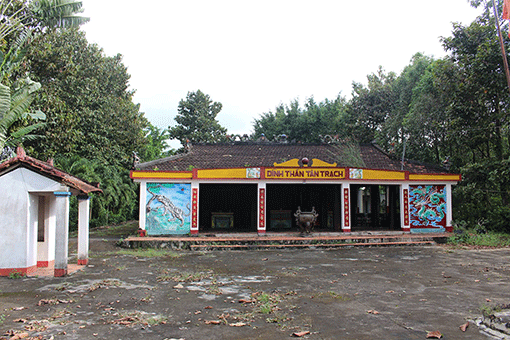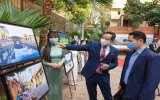An antique temple of peaceful space
From the first days of setting up the village, Vietnamese people have set up communal houses to worship local land gods with the desire for the villagers to be protected and blessed against all difficulties and challenges. People of small villages on Bach Dang islet had also soon established separate communal temples for their own villages, including Tan Trach communal temple which was ranked as a historical and cultural relic at the provincial level by Binh Duong provincial People's Committee.

A corner of today Tan Trach Temple
Vietnamese-style temple
From Uyen Hung ward, crossing Bach Dang bridge, turning right and then heading straight for another 1km to reach the relic of Tan Trach communal temple. The temple is located at Hamlet 3, Bach Dang commune, Tan Uyen town on a relatively flat land with a total area of more than 2,380 square meters. As soon as we arrived, we could feel the peace and tranquility because the fruit trees are everlasting green and cool all around. Nguyen Tan Phat, Head of Culture and Information Division of Tan Uyen town, said that Tan Trach Communal Temple was ranked as historical and cultural relic on October 30, 2007 by Binh Duong provincial People's Committee. The communal temple is not only a relic at the provincial level, but also plays an important role in the formation of the village system on Bach Dang isle. Tan Trach communal temple was established by the people of Bach Dang islet to worship local god deity, the land-founding god of the locality. In addition, the communal house is also a place to show gratitude to heroes who have sacrificed for their homeland.
According to documents, Tan Trach communal temple was built in 1854, year of the tiger. The communal temple was built according to Chinese letter of ding, consisting of two yin-yang tiled roofs on the entire frame of trusses, columns, and transparencies made of precious wood. At first, the communal village had 54 wooden columns with a diameter of 40-50cm each. However, due to war and the erosion of time, the 22 pillars on the outside were badly damaged. By 1966, the temple was restored and repaired and 22 outside pillars were replaced with concrete columns; all rafters were made of iron and Western roof tiles (instead of yin-yang tiles) and lined brick floor.
For the layout, the temple has 2 parts: the main and the middle halls. The main hall is the place for worshiping the main deity (local land god). The altar had an engraved word of "God" painted with gold on a red background. The two sides are for worshiping ancestors at the front, descendants on the right and the left sides. Next is the interior council altar built of bricks; the table top is lined with blue and white ceramic tiles, decorated with patterns of flowers. The middle part places the altars of the associations and the worshiping boards, also built of bricks. The front is decorated with the picture of Tiger of the jungle; on the table is a set of blue and white ceramic incense burners. In the two corners of the lobby are two altars to worship martyrs of Bach Dang commune.
From the main entrance, in the communal temple on the left side is where the locals worship Tiger God, next is the shrine to worship Mystic of the nine skies. Opposite to the Tiger God altar and Mystic of the nine skies altar are altar Farming God and altar of Balanced Goddess. Facing the front of the pavilion is a screen made of concrete. The screen is decorated with a beautiful landscape of water painting, adding to the beauty and majesty of the temple.
Values in all aspects
For the French colonial stage until 1945, Tan Trach communal temple was occupied by the French colony who used it as a base for the persecution of the people. Therefore, the villagers of Tan Trach had no place to worship the god of their village. Not only did they occupy the communal house, the French soldiers also cut down a number of valuable wooden pillars in the temple while some were partly damaged by termites, so the temple was severely degraded. Most of the wooden columns in the house and 22 wooden columns outside the corridor were affected; they no longer retain their original values.
By 1966, as the war situation changed, Tan Trach people seized the temple. Since then, they have contributed their efforts to repair the village's sanctuary. The 22 damaged wooden columns have been rebuilt with concrete. By 2003, the local people once again repaired and renovated the whole temple. The communal temple is always given rituals and people in the village have tried to preserve everything ever since.
Nguyen Tan Phat added that, at present, Tan Trach communal village is still maintained with traditional forms of festivals from the past to the present. In particular, the Ky Yen festival is one of the biggest festivals of the communal temple, held solemnly on the full moon day of January every year by the organizing committee. The festival is an opportunity for people to honor merits and to appreciate the merits of ancestors worshiped in the communal temple. At the same time, the committee also propagates so that people could understand the value of the relics and relevant laws; it also promotes propaganda and implement cultural lifestyle in the festival to make the festival more and more civilized and really become the cultural festival of the people to positively contribute to the local economic and cultural development.
For many years, on the occasion of July 27, Bach Dang commune also cooperate with the committee to organize rituals to commemorate martyrs who had sacrificed for their homeland and country. For each time, relatives of martyrs' families and people in the commune attend in crowds. Along with other relics in the town area, Tan Trach communal village is also holding relic values that had been paid attention to and promoted.
Reported by Cam Ly - Translated by Vi Bao
 Two Vietnamese win S.E.A. Write Award
Two Vietnamese win S.E.A. Write Award
 Vietnam begin Asian Esports Games 2024 with win over Thailand
Vietnam begin Asian Esports Games 2024 with win over Thailand
 "Every throw is infused with my deepest hope"
"Every throw is infused with my deepest hope"
ITF U18 – J30 2024 Tournament wraps up in Ninh Binh
 Anniversary of Tan Khanh Ba Tra martial arts celebrated
Anniversary of Tan Khanh Ba Tra martial arts celebrated
 Binh Duong ready for Dong Nam Bo Judo Open Tournament 2024
Binh Duong ready for Dong Nam Bo Judo Open Tournament 2024
 Vietnam promotes cultural heritage values for sustainable future
Vietnam promotes cultural heritage values for sustainable future
Vietnamese culture promoted in Laos
 More than 10,000 runners to join Binh Phuoc Marathon
More than 10,000 runners to join Binh Phuoc Marathon
 More playgrounds created for the public
More playgrounds created for the public



